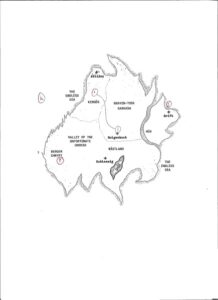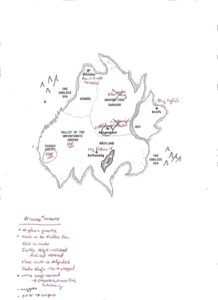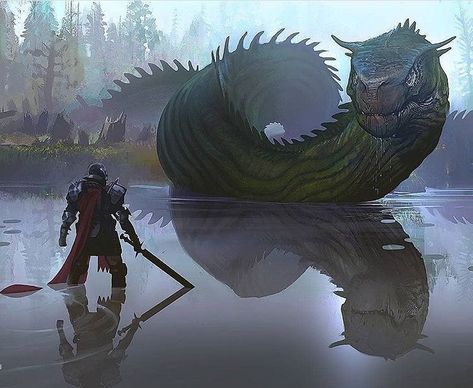This is the big Mörk Borg game I’ve been playing for months at Spelens Hus. It began with a bit during Augustifesten, then we rebooted and expanded it to the regular group, with four players, and two more joined us along the way. These players are all about fifteen; without commenting further, they are thoroughly attuned to the game’s cheese-metal aesthetic, including the text’s amusing qualities which keep it from being dumb.
After the session I described in First verse, I wanted to play a good solid series, using the text’s adventure generation procedures, and to enjoy the unusual rules for developing characters as well.

I won’t go so far as to say I hate the designated optional add-on materials in the core book. I definitely don’t like them. I think most of the options for characters – classes and backgrounds – work against the game’s best concept, and if I ever used them, it would be very minimal. I used some of the background tables for some of my NPCs, and I did use the optional catastrophic effects for magic. [In case it’s not obvious, I don’t own any of the many other available publications for the game and I have no idea what’s in them. Nor have I watched any videos or looked at any promotional material.]
So you know, the book includes many tables in different textual locations, without guidance for use beyond their section titles and sometimes not even that. One decides or figures out how to use them, that’s all, which isn’t hard but is necessarily one’s own brew of what to do. I typically rolled for the following sections, sometimes fully and sometimes ignoring this or that table:
- The first few pages: names, occult treasure, traps & devilry, weather, corpse plundering
- Adventure: where do you wander, who (or what) contacts you, adventure spark
- Dungeon (location): name, status, imminent danger, inhabitants, distinctive feature, and a set of tables for a given room/area
The results vary widely in lore/setting terms, from “really important” to “a momentary detail,” but what matters is how one processes them. For example, here are my notes taken as I rolled for the components of the first adventure and its complications:
The best way to do this is simply to be playful and extend whatever you want into whatever you want. I noted that “bark witch” isn’t found anywhere else in the text, so it means whatever I want it to, incluing tying it to “underworld emission of poisonous spores.” So I spitballed it into some kind of vegetation-nature-rebirth person who used the blindfold to get into this awful Death place to defy the impending end of the world.

In play, this adventure kept unfolding like a hip 1990s fractal graphic. It began with all sorts of criss-crossing magic, e.g., “black prism twists all powers,” “terrifying inscriptions,” “teleportation inscriptions,” plus a remarkable coincidental confluence of magic thrown around by the characters (“well, if they do that while this is happening, then …”). Briefly, following many shenanigans concerning root-golems, flammable spore clouds, and exhumed angry corpses, the witch-dude opens a freaking portal to somewhere else, so I rolled anew for basically a new adventure (the third and fourth pages in the above PDF); and I found and/or interpreted all the information for maximum significance. …
- So we’re right in the thick of Josefa Milgol’s necromantic citadel, including a priest of Nechrubel, for which I used the same map but inverted it so it’s a downward underground cone.
- There’s only one entity in the whole lore who’s oriented toward creation and birth, SHE, the mama basilisk. Poisonous, evil, vicious, and awful, yes, but also the only being capable of opposing HE and not inclined (or one head isn’t anyway) to tolerate the end of the world.
Eventually, including two character deaths, we played the overthrow/annihilation of Josefa Milgol, and SHE is awakened, as expressed by a big reptilian eyeball in the “mirror of shameful truths.” I won’t claim that the sudden escalation in metaphysical significance was dictated, but the door was certainly flung wide open and I walked through.
My notes for the second adventure demonstrate the process too. You’re seeing the components as I rolled them, then, after filling the page, modified by circles and lines which show how I associated or combined or identified them as the same things.
Again, it seemed absurdly coherent: the Basilisk’s Demand [imposed upon them by SHE] was “silver from a sinner’s grave” + the magical item was a silver cage which kills its ccupant and turns them into a horrible undead + the “well-dressed corpse;” the location was in the Endless Sea + the Misery which appeared was enormous waves on the Endless Sea; certain foes were “dissident courtiers dedicated to the occult” + “remains of a throne” …

I was wary of merely playing set-pieces, so GMed things one moment at a time, beginning with the onset of the waves as their ship approached the island. I really liked how it played from there. Events proceeded through different characters choosing to do different things with different NPCs in different places. It included an eerie banquet in the courtiers’ strange estate which turned into an exceedingly violent fight; by contrast, a believable and robust gathering of the working-people in a barn; and a big question of whether and how they could escape the island in the busted-up but still-working ship. We understood and developed precise locations within the estate and across the island.
For the third adventure, I took some time to review world-information and the events so far, and also to develop NPCs and locations rather than just foes and fight-maps. We began play with some overview of the text’s sketchy setting and the “basilisk thing.” Here are my notes:


What happened in the third adventure: players picked up the relationships and backstory, lots of characterizations. could tell I was getting a little tired, though
In preparing the final adventure, I looked at the world, which had become quite different directly due to the adventures we played.

It also strikes me that maybe not everyone reading is familiar with the apocalypse and the Miseries, as the whole context of play. Since it’s available for free at the Bare Bones link above, I will only highlight these procedures:
- There’s an apocalyptic prophecy by Verhu (one of HE’s heads), possibly instigated by Nechrubel (a cruel death-deity), possibly actually instigated by Arkh (one of SHE’s heads)
- It’s apparently coming true, as the final Miseries are beginning to appear
- You roll for a Misery every fictional game-day; you get one on a 1 [choose your die; I used a d6]
- If you get a Misery, roll to see which one; some of them are pure weird phenomena and some are tied to specific metaphysics or entities
- The seventh Misery is indeed the end of the world; “the darkness will swallow the darkness,” rahr, arrghh
Therefore, to clarify some things I wrote earlier, almost from the start of play we tapped into the possibility of stopping the end of the world. Although that concept could conceivably not enter play and it would all just end as prophecied, I want to stress hard that this possibility is actually accessible through a wide variety of rolled preparation details, as well as various confluences of played outcomes. Our final adventure was effectively a showdown between SHE’s non-apocalyptic head and the onset of the Miseries, which at that time numbered five, expressed as a confrontation between the characters and Arkh, SHE’s other, more malevolent head.
Perhaps I am not being clear. For fifty years, fantasy role-playing products have promised us that we would play intrepid little nobodies who would, if they survive, rise to prominence or at least significant presence in the face of outstanding geopolitical and cosmic events, including Reality as We Know It (man). It is the Tolkien revival + the Moorcock arisal, both in the mid-late 1960s and cresting by the mid-70s, fully intertwined and complementary, both infused with psychedelic rock and the birth of metal. Whole lifetimes have broken on the rocks in the attempt to receive this promise, and some of us have become skilled in making it happen against the limitations of our understanding or the contradictions of badly-made instruments, whether honestly or dishonestly.
Well, here it is, and great to see presented with such functional enthusiasm by persons aside from myself and very few others. It’s significant for me, too, to be playing with people at the exact age that I felt most enthusiastically committed to such topics myself.
I’d really like to discuss the rules for character improvement, but that may require a video presentation to dig into it. For now, here is Theo’s character Katla going into this adventure.
My preparation for the fourth and final adventure:
I didn’t play the final session very well in some ways. Although I’d developed a pretty good idea for the sailor, I totally forgot about it as we began, and I also forgot about the lingering effects of a narcotic curse one of the characters should have been carrying. In plot and setting terms, I thought I’d prepared quite a fight, but the players were too smart and used their scrolls very effectively against Arkh and Presence appeals very effectively toward Lusi; I suppose I could have been more climactic and perhaps brought in HE for a bigger confrontation, but that struck me as in-session manipulation so I didn’t.
I haven’t really done the players justice in this account, including one of them who managed to survive with only the tiniest few hit points and fortunately never failed with the Open Palms scroll, another who cared greatly about his mule, another who perished along with her monkey to universal sadness and acclaim, another who used a grappling hook for just about anything one may imagine, another who always conversed with the foes for occasional surprisingly useful results, and more.


4 responses to “Dead quiet, piercing wind, cloudburst, gravelike cold”
It’s certainly interesting to get a “behind the scenes look”, since I was the player of Katla. Mörk Borg is definitely a cool game, and I’d say that it works for beginner players too considering this was my first time playing an actual roleplay-boardgame.
I’d like to spend a little time with our group to examine how we play a given game, each time. It’s especially important to learn that game mastering is not a special or mysterious art, but only a particular set of jobs or activities, which are different for each game.
Actually “bark witch” is from Pelle’s earlier game Barkhäxan, i.e. The Bark Witch
It’s in the content tables in Mörk Borg, which is where I rolled it, meaning, nothing to do with the other game.